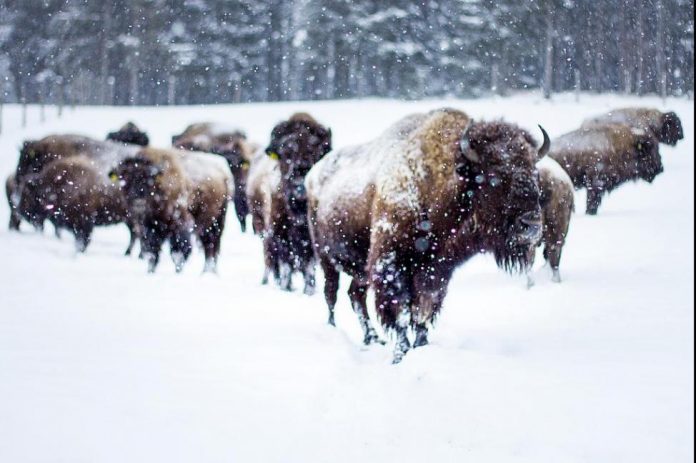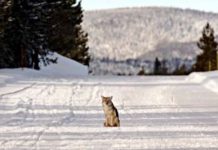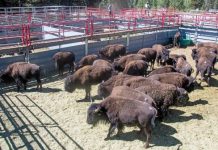
DENVER, Nov. 18 (UPI) — Bison that leave Yellowstone National Park’s safety zone face being shot at close range in a yearly hunt characterized by nearby Montana residents as a slaughter, and a federal judge has declined to temporarily stop the event.
The Beattie Gulch bison hunt has been held for years, but this year opponents tried to stop it with a federal lawsuit, claiming it was dangerous and gruesome and destroyed tourist business.
Members of Indian tribes with treaty-granted rights travel hundreds of miles to Gardiner, Mont., to participate in the hunt. Some tribe members say they don’t want to give up a sacred and ceremonial event, but add they find the hunt degrading for humans and the bison.
The Beattie Gulch shootouts create a “kill-box mentality” and are a convenient way for National Park Service and Montana state officials to cull the bison population, said James Holt, a former Nez Perce tribal council member and executive director of the Buffalo Field Campaign.
“The federal government is just utilizing the tribes as a management tool, rather than supporting responsibility to have a humane hunt. Tribes are caught in the crossfire of that bison management mode,” he said.
Herds of bison start to migrate, sometimes hundreds at a time, when winter snow buries grass in Yellowstone’s mountains. They wander out through a natural bottleneck near the park’s north entrance onto U.S. Forest Service land.
There, a wall of hunters awaits, including tribal members and others with hunting permits from Montana’s Department of Wildlife Fish and Parks. Groups of 50 hunters at a time line up to shoot the bison at close range.
“Sooner or later the chaotic, overcrowded, and unsafe bison hunting at Beattie Gulch will kill or seriously injure someone,” said the suit filed by Gardiner resident Bonnie Lynn and her group, Neighbors Against Bison Slaughter.
A District of Columbia federal judge agreed Thursday to allow a request from defendants National Park Service and the U.S. Forest Service to move the case to Montana District Court. Chief Judge Beryl A. Howell did not rule on a request for a temporary injunction to stop the hunt.
Attorneys will make their case before the Montana court in upcoming weeks, asking for an accelerated decision.
A killing field
Bison hunting season in Montana starts in mid-November and lasts through the winter.
Neighbors have complained for years that the shootout and its grisly aftermath ruin business for vacation rental cabins and scares tourists away.
Hunters skin the bison, leaving behind gut piles weighing hundreds of pounds that attract scavenging wildlife and raptors. Ravens drop the offal onto trees and homes and leave the area an “open-air charnel house,” the suit says.
Yellowstone’s bison do not have a flight instinct when they encounter humans because of the thousands of tourists who come to view them every year, said Nathan Varley, president of the Bear Creek Council, an environmental advocacy group for the area around Yellowstone.
“The bison don’t trickle out into the forest like elk or deer. They walk right down the roads where the houses are,” Yarley said.
But when they leave the national park’s friendly confines, they run into “a lot of bullets flying and a lot of people and animals [are] in harm’s way.”
“I’m a hunter and I would never participate in it, the way it’s set up,” Varley said. “Tourists who see the killing fields and gut piles near the roads don’t expect to see something that looks like the buffalo slaughters from the 1870s.”
Tribal members conflicted
Not all tribal members are offended by the hunt, which is a way to maintain “cultural traditions and lifeways,” a group of tribes said in a brief filed with the court.
Treaty rights date to 1855 for members of tribes from the inland Northwest, including Confederated Salish and Kootenai Tribes of the Flathead Reservation, the Nez Perce Tribe, the Yakama Nation and the Confederated Tribes of the Umatilla Indian Reservation.
But Holt said most tribal ceremonial and cultural hunts ideally would not take place in winter, when bison cows often are pregnant and the animals are vulnerable. The hunts feel disrespectful to the U.S. national mammal, he said.
“Some animals run back into the park to die,” Holt said.
Survived near-extinction
Yellowstone’s bison herd of more than 4,500 animals is genetically pure without cattle DNA and descended from about two dozen animals that survived near-extinction in the 1800s.
But many of the animals carry brucellosis, a bacteria-based disease that can cause pregnant cows to abort their offspring.
For that reason, cattle ranchers near the park want bison kept away because they fear the bacteria will be transferred to livestock. Any bison outside the park is fair game for hunters.
A proportion of Yellowstone bison is kept in quarantine every year until deemed free of the disease, and then the animals are sent to be slaughtered by Native American tribes, who distribute meat and hides to their members.
State officials concerned
Even state wildlife officials have worried that the Beattie Gulch hunt is a disaster waiting to happen.
“The fear for injury or death to hunters is real,” officials wrote to the park service, according to the complaint. “The density of hunters has increased beyond what [Montana Wildlife] considers safe.”
Representatives from Montana Wildlife Fish and Parks declined to comment on the pending litigation.
The park and other cooperating agencies have discussed blocking off Beattie Gulch and forcing the bison to disperse in thinner groups, farther away from residential areas, but no such plan has been put in place this year.
The news spreads fast when the bison herds start to move, and the town fills up with hunters. Neighbors are just hoping no-one is injured this year and that the gut piles don’t last too long.
“The Yellowstone bison are a legacy,” Bear Creek Council’s Varley said. “They had their last stand in this country and they made an amazing comeback, and they’re just not being valued by any of the players here. History will judge us hundreds of years from now.”





